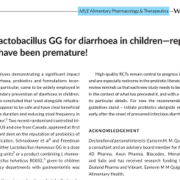L. rhamnosus GG for treatment of acute pediatric diarrhea: the totality of current evidence
By Mary Ellen Sanders PhD, Executive Science Officer, ISAPP
For the past several years, studies have been adding to the evidence base on the efficacy of Lactobacillus rhamnosus GG for the treatment of pediatric diarrhea. A new systematic review and meta-analysis led by Prof. Hania Szajewska concluded that Lactobacillus rhamnosus GG is effective for treating acute diarrhea in hospitalized children, even when a 2018 null trial (Schnadower et al. 2018) was included.
“Despite a recent large RCT demonstrating no effect of L rhamnosus GG, current evidence shows that, overall, L rhamnosus GG reduced both the duration of diarrhoea (with a higher impact in European countries) and hospitalisation in inpatients.”
The authors acknowledge that the quality of evidence for this conclusion is low: 13 of 18 included studies suffered from problems with randomization, allocation concealment, blinding, and/or follow‐up. However, the rigorous process used to assess the current state of evidence provides confidence in the paper’s conclusions.
In an editorial in Alimentary Pharmacology & Therapeutics, Prof. Eamonn Quigley suggests that reports dismissing L. rhamnosus GG as ineffective (for example, see The Washington University School of Medicine opinion, “Probiotics no help to young kids with stomach virus“) were premature.
As Prof. Quigley points out, it is necessary to put the findings of the null study into context. He states several reasons why the Schnadower et al. 2018 study may not have shown an effect of L rhamnosus GG, even though previous studies had. Notably, the rotavirus vaccination status of the subjects – with two-thirds of the study population having been vaccinated – seemed important. Subgroup analysis showed that the probiotic was more effective among children who had not been vaccinated for rotavirus.
In addition, as discussed in a previous ISAPP blog, the timing of initiating probiotic therapy is likely an important factor. In the null trial, the average time of diarrhea prior to treatment was 53 hours, and subjects were enrolled up to 72 hours after onset of diarrhea – likely too late to have a possibility of positive impact by the probiotic.
For now the ESPGHAN recommendation to initiate L. rhamnosus GG treatment in conjunction with rehydration therapy early after the onset of diarrhea in children can still be supported by the totality of evidence.
Both Prof. Hania Szajewska and Prof. Eamonn Quigley serve on the ISAPP board of directors.





